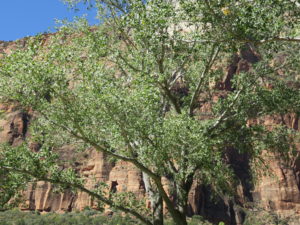Many property owners choose fast growing landscape trees. These large shade trees increase the value of your property. Their summer shade and wintry wind protection may reduce utility bills by 20 – 25% . Trees attract wild birds for nesting, protection, and as a food source. Some brighten up your landscape with dazzling fall color. However, we may pay a price for the fast growth.
Trees listed here are rated as fast growing. In general, most (not all) fast growing trees are weak wooded. Branches may break apart under ice or snow loads and in high winds. Their shallow roots may uplift or crack sidewalks. Do not plant fast growing species within 50 feet of your home as tree roots may penetrate foundations and septic fields. This is particularly true for silver maples, cottonwoods, poplars, and weeping willows. Some species are also susceptible to verticillium wilt, leaf anthracnose, and cankers; pests like scale and borers may be troublesome at times.
Do not assume that all listed species are troublesome. Those marked by an asterisk (*) are superior trees and are highly recommended. All species are rated hardy in USDA zones 5-8. Better cultivars are listed for a few species.
Fifteen Large Fast Growing trees (25 feet or more high after 10 years):
Box elder (Acer negundo)
*Silver Maple (Acer saccharinum) ‘Silver Queen’
Tree of Heaven (Ailanthus altissima) – rated an invasive species in some states
Common hackberry (Celtis occidentalis)
*Tulip poplar, tulip tree (Liriodendron tulipifera)
Empress tree (Paulownia tomentosum) – rated an invasive species in some states
*London Planetree (Platanus x acerfolia)
Sycamore, planetree (Platanus occidentalis)
Eastern Cottonwood (Populus deltoides)
Lombardy poplar (Populus nigra ‘Italica’)
Quaking aspen (Populus tremuloides)
Weeping Willow (Salix babylonica)
*Basswood, American linden (Tilia americana)
*American Elm (Ulmus americana) ‘Washington’, Princeton’, ‘Jefferson’
Siberian elm (Ulmus pumilo) -rated an invasive species in some states




 Posted in
Posted in 
